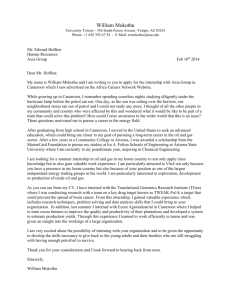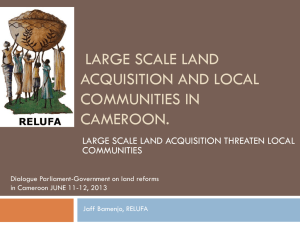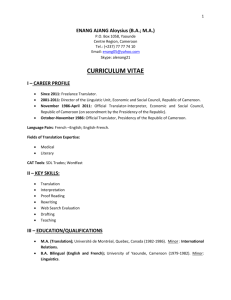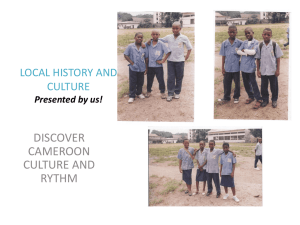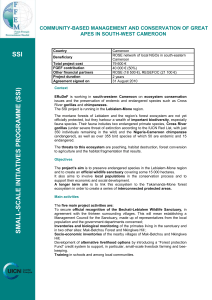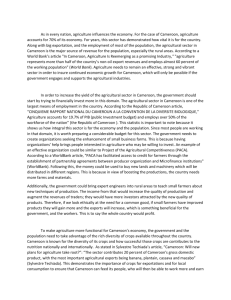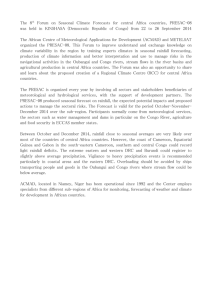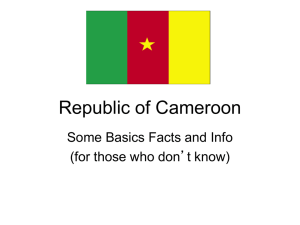Cameroon
advertisement
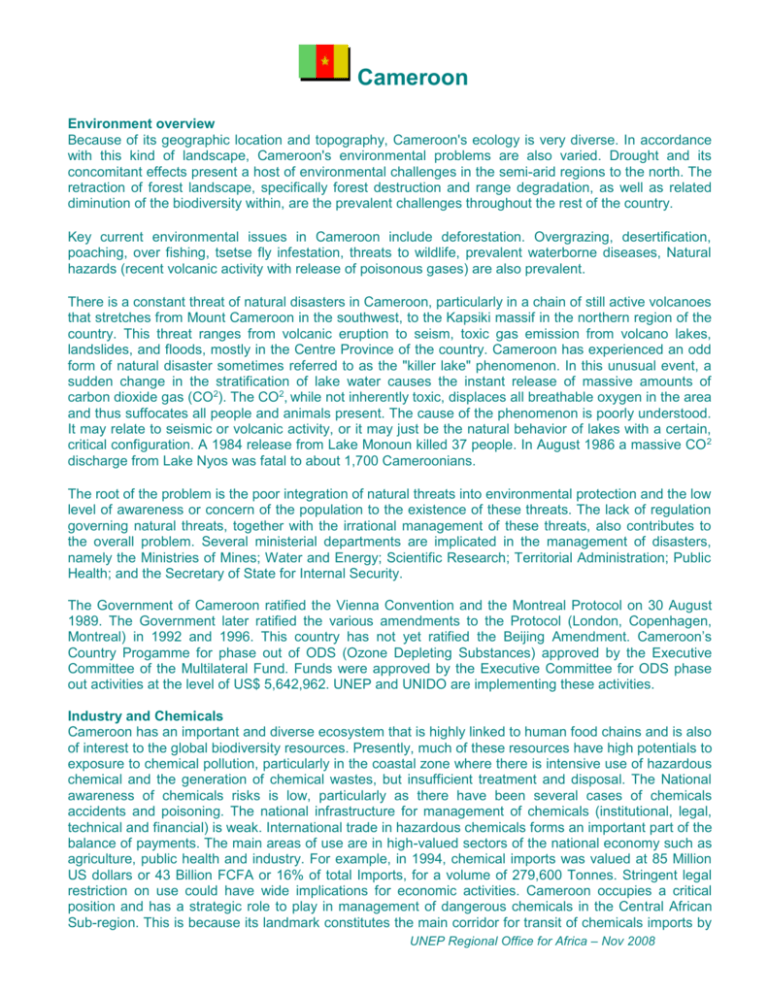
Cameroon Environment overview Because of its geographic location and topography, Cameroon's ecology is very diverse. In accordance with this kind of landscape, Cameroon's environmental problems are also varied. Drought and its concomitant effects present a host of environmental challenges in the semi-arid regions to the north. The retraction of forest landscape, specifically forest destruction and range degradation, as well as related diminution of the biodiversity within, are the prevalent challenges throughout the rest of the country. Key current environmental issues in Cameroon include deforestation. Overgrazing, desertification, poaching, over fishing, tsetse fly infestation, threats to wildlife, prevalent waterborne diseases, Natural hazards (recent volcanic activity with release of poisonous gases) are also prevalent. There is a constant threat of natural disasters in Cameroon, particularly in a chain of still active volcanoes that stretches from Mount Cameroon in the southwest, to the Kapsiki massif in the northern region of the country. This threat ranges from volcanic eruption to seism, toxic gas emission from volcano lakes, landslides, and floods, mostly in the Centre Province of the country. Cameroon has experienced an odd form of natural disaster sometimes referred to as the "killer lake" phenomenon. In this unusual event, a sudden change in the stratification of lake water causes the instant release of massive amounts of carbon dioxide gas (CO2). The CO2, while not inherently toxic, displaces all breathable oxygen in the area and thus suffocates all people and animals present. The cause of the phenomenon is poorly understood. It may relate to seismic or volcanic activity, or it may just be the natural behavior of lakes with a certain, critical configuration. A 1984 release from Lake Monoun killed 37 people. In August 1986 a massive CO 2 discharge from Lake Nyos was fatal to about 1,700 Cameroonians. The root of the problem is the poor integration of natural threats into environmental protection and the low level of awareness or concern of the population to the existence of these threats. The lack of regulation governing natural threats, together with the irrational management of these threats, also contributes to the overall problem. Several ministerial departments are implicated in the management of disasters, namely the Ministries of Mines; Water and Energy; Scientific Research; Territorial Administration; Public Health; and the Secretary of State for Internal Security. The Government of Cameroon ratified the Vienna Convention and the Montreal Protocol on 30 August 1989. The Government later ratified the various amendments to the Protocol (London, Copenhagen, Montreal) in 1992 and 1996. This country has not yet ratified the Beijing Amendment. Cameroon’s Country Progamme for phase out of ODS (Ozone Depleting Substances) approved by the Executive Committee of the Multilateral Fund. Funds were approved by the Executive Committee for ODS phase out activities at the level of US$ 5,642,962. UNEP and UNIDO are implementing these activities. Industry and Chemicals Cameroon has an important and diverse ecosystem that is highly linked to human food chains and is also of interest to the global biodiversity resources. Presently, much of these resources have high potentials to exposure to chemical pollution, particularly in the coastal zone where there is intensive use of hazardous chemical and the generation of chemical wastes, but insufficient treatment and disposal. The National awareness of chemicals risks is low, particularly as there have been several cases of chemicals accidents and poisoning. The national infrastructure for management of chemicals (institutional, legal, technical and financial) is weak. International trade in hazardous chemicals forms an important part of the balance of payments. The main areas of use are in high-valued sectors of the national economy such as agriculture, public health and industry. For example, in 1994, chemical imports was valued at 85 Million US dollars or 43 Billion FCFA or 16% of total Imports, for a volume of 279,600 Tonnes. Stringent legal restriction on use could have wide implications for economic activities. Cameroon occupies a critical position and has a strategic role to play in management of dangerous chemicals in the Central African Sub-region. This is because its landmark constitutes the main corridor for transit of chemicals imports by UNEP Regional Office for Africa – Nov 2008 Cameroon most of the neighboring countries. However, no specific sub-regional agreements or harmonized procedures exist among the countries for management of dangerous chemicals in such areas as accident prevention and response. Cameroon has interests to participate in negotiations in International Conventions on chemicals - so as strengthen its national capacities in the areas of technology transfer, legislation, public education, the development of exploitation of her natural resources that could be used to manufacture non-chemicals alternatives. Water and Sanitation Pipeline leakages, groundwater contamination and fresh and marine water pollution are ever-present dangers, especially since the pipeline makes at least 17 major river crossings. Also highly criticized has been the project’s lack of a site-specific emergency response plan to deal with an oil spill. Even one leak would endanger communities all along the pipeline route because they rely on surface water systems for most of their water needs. The offshore loading facility from which millions of barrels of oil will be transferred onto tankers will be located between Cameroon’s only two nature preserves. A spill would be catastrophic and destroy the local fishing and tourism industries on which coastal inhabitants depend for survival. Biodiversity Cameroon is endowed with a very rich biodiversity and this is explained by its geographical location near the equator and in the heart of Africa, rich volcanic soils in the south and good watershed, which accounts for good drainage systems. After Democratic Republic of Congo, South Africa and Madagascar, Cameroon comes 4th in biodiversity richness with a high degree of endemism. This rich biodiversity is seriously under threat with heavy reduction of species numbers through agriculture, fishery, forestry activities and wildlife poaching. An ecological assessment (Table 2.1) shows that Cameroon has a great potential which ranges from the closed tropical rainforest which also contains biodiversity conservation areas to arable land and pastures. The ecological value of the green environment is estimated at about thousand million CFA. Within the Tropical forest zone, the slash and burn method of agriculture and forestry activities are the principal causes of loss of biodiversity. Inventories have been made on about 14 million hectares of high forest and a potential of 4.165 billion cubic meters of timber is considered available. Cameroon is party to the Convention on Biological Diversity and the Cartagena Protocol. Natural Resources Cameroon is endowed with a forested area of 19.598.000 ha (FAO, 1997) 18.000.000 ha of this forest is located in the humid forest zone. During the last decade, the share of forest related activities in the economy has significantly increased. For instance, in 1995 export of timber products has amounted to US$321 millions, representing 19.8% of the total value of Cameroon exports. The contribution of timber harvesting to GNP has also risen, from US$ 488 millions in 1990 to US$ 612 millions in 1995, the equivalent of 6.7% of the GNP. Cameroon has some of the greatest biodiversity in Africa, and also has the highest percentage of logged forest of any African nation with substantial rain forest. Even though Cameroon is still richly endowed with tropical forests of high quality (in fact in terms of quality, its forest is second only to Democratic Republic of Congo) and deforestation does not take place at a high rate yet. UNEP Regional Office for Africa – Nov 2008 Cameroon Most of the deforestation is the result of small-scale agricultural activities: shifting cultivators are estimated to be responsible for 79% to 95% of all deforestation in Cameroon. However, it was noted the indirect role played by timber in deforestation in Cameroon. Although the expansions of agricultural and timber production activities are basically the proximate factors causing deforestation in Cameroon, the more important underlying factors, mainly the economic incentive effects that may have been influenced by the SAP still need to be identified. Land degradation Land degradation has been identified as one of the major environmental challenges facing the central Africa sub-region. The main contributors to land degradation in this sub-region are erosion and soil compacting, as a result of extensive removal of vegetation, and exposure of the soils to heavy rainfall, increased evaporation and wind action. The main reasons for vegetation removal are commercial logging and tree cutting to provide domestic fuel, as well as clearance of forests for commercial or subsistence cultivation. Cameroon is one of the Sudano-Sahelian countries in Africa that shows signs of some desertification. The northern part of the country was previously under forest, and due to the extreme degradation of vegetative cover, it’s now under savannah grasslands. It appears therefore that deforestation in Cameroon should be the preoccupation of environmental and human resource economists, ecologists as well as policy makers because of its threat to ecological sustainability and socio-economic development in the long run. Partnership for Congo Basin Forests: The country has engaged in a strong partnership with other countries in the Congo Basin, with the view to manage their natural resources in a sustainable way. At the World Summit for Sustainable Development, the United States joined forces with the governments of Cameroon, the Central African Republic, the Democratic Republic of the Congo, Equatorial Guinea, Gabon and the Republic of Congo along with multilateral donors to promote economic development in the Congo River basin through natural resource conservation programs. The program creates a network of parks and protected areas, well-managed forestry concessions, and assistance to communities who depend upon the conservation of the forest and wildlife resources in the Congo River Basin. The United States planned to invest $53 million through 2005 on this project and additional government, intergovernmental, and non-governmental partners are also expected to contribute funds. The “Partnership for Congo Basin Forests” aims at sensitizing the international community on the threats facing the world second biggest tropical forest, which provides ecological services to humanity. The “Partnership for Congo Basin Forests” intends to support a network of around 10 million hectares of national parks and protected areas in the perspective of sustainable management of forests. UNEP Regional Office for Africa – Nov 2008
